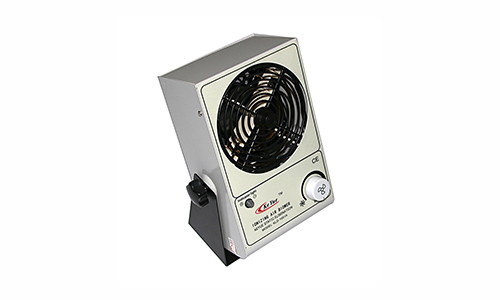Now more and more factories choose ion fans to remove static electricity. Many people think that the ion blower can remove static electricity as long as it can blow out air, so the test of the ion blower is often ignored. If the ion fan blows ordinary air instead of ion air, the product quality will be greatly affected. Today, we will introduce the purpose and method of the ion fan test:
Test purpose
The purpose of the compliance verification procedure is to verify that the loss time and residual voltage (ion balance) of the ion blower are within the specifications of the user; The test process in the periodic test procedure is generally applicable to the following types of ionization equipment; Ion chamber, laminar flow hood, working platform and automation equipment (desktop and hanging), air jet (spray gun or nozzle).
Test equipment required for preparation
Flat electrostatic monitor. Stopwatch or other suitable timers are generally used when measuring the loss time with a portable tester.
Test program -- initial test setup
The test point shall be located in the direction of ion neutralization ESDS components; During the test, the ionizing air heater or air filter (if equipped) shall be kept under normal operating conditions.
Test procedure -- loss time test
1. Turn over the test equipment and make it stable as recommended by the manufacturer;
2. Ground and separate the conductive plate for a short time to make it (or verify) return to zero;
3. The tester shall not return to zero (or charge) after the grounding is disconnected in the environment with ions;
4. Charge the conductive plate to any north and south pole voltage that exceeds the initial test voltage (such as ± 1200 to ± 1500 V);
5. Ensure that the conductive plate faces the air flow of the ion wind;
6. The measurement of loss time starts when the voltage of the conductive plate decays to the initial test voltage (generally ± 100 V) and ends when the test voltage is suspended (generally ± 100 V);
7. Repeat the above procedure to test the opposite polarity voltage;
8. Record the number of seconds of voltage loss time at the north and south poles;
Residual voltage test (balance)
1. Turn over the test equipment and make it stable as recommended by the manufacturer;
2. Ground and separate the conductive plate for a short time to make it (or verify) return to zero;
3. The tester shall not return to zero (or charge) after the grounding is disconnected in the environment with ions;
4. Place the conductive plate against the airflow of the ion wind;
5. Wait for the reading to be stable;
6. Record the residual voltage (balance).
